Chile’s capital is investing millions in energy efficiency upgrades and renewable energy projects for public buildings to reduce emissions and toxic smog levels.
Santiago is aggressively investing in renewable energy projects and efficiency upgrades for their schools, hospitals, and other public buildings. Between 2015 and 2018, the city will invest almost $5 million in rooftop solar projects and efficiency retrofits expected to deliver significant reductions in utility bills and emissions for the municipally owned buildings. By aggregating demand across all of the projects, the municipality was able to drive down the cost of solar from $5.40 to $0.96 per installed watt.
3,419 tons of CO2 saved annually from the clean energy investments and efficiency upgrades
Cities100 – 2017
As the city is surrounded by mountains, heat and toxic gases can be trapped in the city bowl, leading to dangerous levels of air pollution. On several occasions the city has been forced to temporarily “shut down” due to high levels of toxic air pollutants. This project is one part of the Regional Strategy of Resilience aiming to cut energy consumption levels and derive more energy from local renewable sources. This drive towards cleaner energy is mirrored on the national scale, which has seen Chile double its renewable energy capacity between 2013 and 2016.

The challenge
Santiago generates only 43% of the electricity the city consumes, with more than half of electricity generated from imported diesel and gas. Increasing the local generation of clean energy and ramping up energy efficiency will contribute to reduced emissions, healthier air for citizens, and reduced dependency on fuel imports.
Co-benefits
Economic The solar energy systems installed on 15 public roofs generated savings of $140,000 annually, and the efficiency upgrades installed in the first 14 buildings generated $1.2 million in savings per year.
Environmental The savings from the energy efficiency program in hospitals saved an estimated 258 liters of diesel, 1,000 m3 of natural gas, and 1.3 GWh of electricity in the first year.
Health Reducing fossil fuel use via efficiency upgrades improves temperature regulation, noise levels, humidity, and air quality for patients, employees, and visitors in hospitals.
About Santiago
Santiago de Chile is the capital and largest city of Chile as well as one of the largest cities in the Americas. It is the center of Chile’s largest and the most densely populated conurbation. The city is entirely located in the country’s central valley, at an elevation of 520 m (1,706 ft) above mean sea level. Santiago is the cultural, political and financial center of Chile and is home to the regional headquarters of many multinational corporations.


